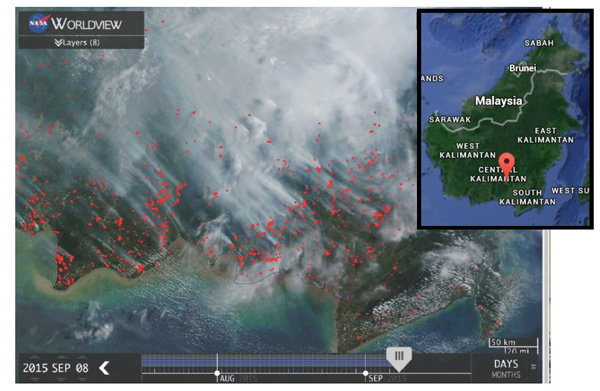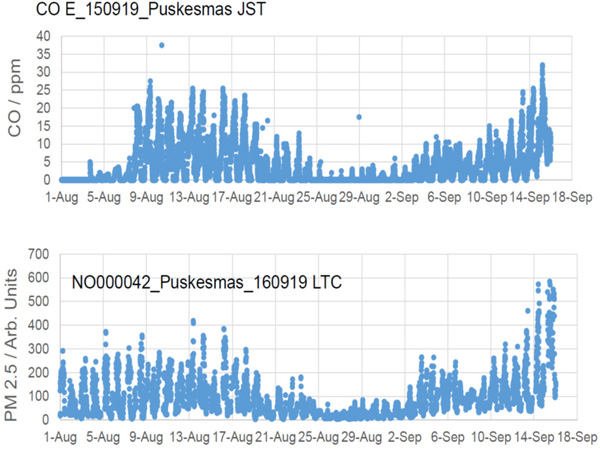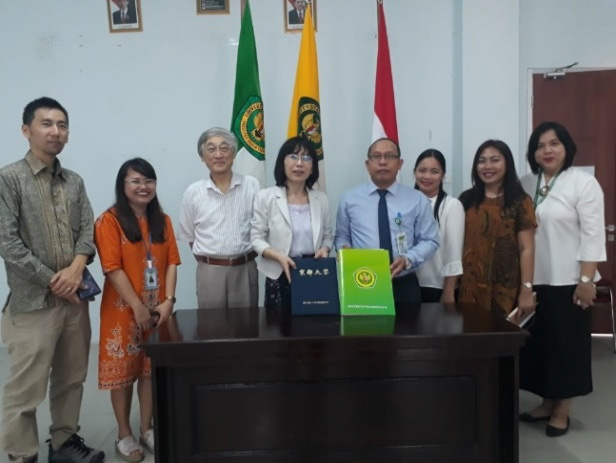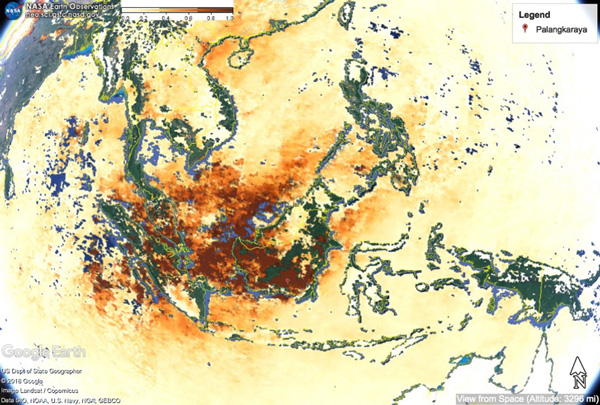Introduction
Peatland degradation and forest fire problems are global environmental problems that require understanding both in terms of social and ecological contexts. Tropical forests and peatlands are high in biodiversity and concurrently high carbon areas. However, climate change and human interventions including economic development and commercial logging as well as large-scale plantations are negatively affecting these vulnerable and fragile systems. Forest and land clearing for agriculture and development and degradation from over-extraction of timber and development of oil palm plantation is leading to rapid peat decomposition and an increase in the incidences of forest fires. These in turn, can result in an increase of carbon dioxide emissions and haze causing incalculable damage to the economy and to the health of people in the region. This article reflects over some of these issues and responses to them in the context of research currently being conducted jointly by both Japanese and Indonesian researchers.
Towards transdisciplinary research on peatland restoration

Fig. 1 NASA Worldview, September, 2015 https://worldview.earthdata.nasa.gov/
Since 2016, we have been involved in a large-scale research project led by Emeritus Prof Kosuke Mizuno (CSEAS) and Associate Prof. Osamu Kozan (CSEAS) on peatland restoration in Indonesia. CSEAS has a long history of committing itself to peatland research in Indonesia since a previous generation of Japanese scholar took an interest in, and pioneered research in the country (Furukawa 1992; Abe 1993)1.
Since the initiation of a large-scale G-COE project (2007–11)2, Prof. Mizuno and his team started conducting intensive research in Riau, and the project now continues a new research initiative entitled “Toward the Regeneration of Tropical Peatland Societies: Establishment of an International Research Network and Proposals for the Future” (2017–22) at Research Institute for Humanity and Nature (RIHN), Kyoto.

Photo 1 Burned peatland forest & Solar image under thick haze conditions in 2015, Central Kalimantan
After forest fires swept across parts of Indonesia in 2015, the Indonesian government established the Peatland Restoration Agency (Badan Restorasi Gambut (BRG)) and Dr. Haris Gunawan, a graduate of ASAFAS, and a peatland scientist at Riau University, was appointed to Deputy of Research and Development, BRG. This relationship led to concluding an MOU between Kyoto University, RIHN and BRG. The Kyoto university team participates in this project as an active support member for research initiatives. BRG is a government organization empowered to implement peatland restoration activities in degraded peatland areas with a mandate to work with local and international researchers who participate in solving problems on the ground with the aim of restoring degraded peatland throughout Indonesia.
In 2015, a series of severe forest fires and subsequent haze swept across parts of Indonesia. The concentration of particulate matter (PM10) in Palangka Raya (Central Kalimantan) reached extremely high levels. According to technical guidelines for calculating and reporting as well as air pollution standard index information, the safe limit for human health PM 10 is <400 ug/m3. If this threshold is passed, the Air Pollution Standard Index (ISPU) is interpreted to be in very unhealthy and can cause increased sensitivity in patients with asthma, bronchitis, and other related diseases. In particular, haze affects the health of children, pregnant women and the elderly.

Fig. 2 The image below in figure 2 shows CO and PM 2.5 data at Palangka Raya have a strong correlation during this fire season. PM 2.5 levels are six times higher than the Indonesian guideline for the PM pollution.
To facilitate research on mitigation measures to minimize haze’s impact on health, in February 2019, an Implementation Agreement was signed between CSEAS and the Faculty of Medicine, University of Palangka Raya. Research headed by Dr Donna Kahanjak (Faculty of Medicine), in collaboration with Dr. Kayo Ueda (Faculty of Engineering and the Graduate School of Global Environmental Studies) from Kyoto University will be conducted by both local key partners.
Air quality monitoring is essential to understand the risk of haze. However, monitoring stations for particulate matter such as PM2.5 and CO are limited in Palangka Raya, Central Kalimantan. To improve this situation, our group members, Profs. Masahiro Kawasaki and Osamu Kozan (Kyoto Univ. and RIHN), Kenichi Tonokura (Tokyo Univ.), Yutaka Matsumi (Nagoya Univ.), Masafumi Ohashi (Kagoshima Univ.) and Mikinori Kuwata (Nanyang Tech. Univ.) are currently working with the local meteorological and geophysical agency (BMKG Kepala Stasiun: Catur Winarti) and municipal environmental and other relevant agencies, to assess a low-cost and easy-handling air quality monitoring system.
The image below in figure 2 shows CO data at BMKG in Palangka Raya, in which the BG level is only slightly higher than in the left figure at Buntoi during the wet season. However, in October during dry season, a strong increase is seen due to peatland fires in Palangka Raya.
Investigating the causes and impacts of forest fires and haze
The Center for International Forestry Research (CIFOR) is one of the key international research institutions based in Indonesia working on peatland issues. Since 2017, we started a Ministry of Agriculture, Forestries and Fisheries (MAFF) funded project entitled “Enhancing climate-resilient livelihoods in boreal and tropical high carbon forests and peatlands” with inter-disciplinary teams based in the region (2017–2020). For collaboration, we work with the Center for International Cooperation in Sustainable Management of Tropical Peatland (CIMTROP) as a local partner to implement research on the field. CIMTROP has been working on peatland issues in collaboration with transdisciplinary stakeholders running workshops and trainings on peatland management and the effects of peatland deforestation on climate change. CIMTROP has also tested the effectiveness of fire suppressant technology, including firefighting foam and peatland restoration.

Photo 2 Faculty of Medicine, Palangka Raya, University, 2019
In collaboration with CIFOR and CIMTROP, University of Palangka Raya, we have been working on forest fires and haze in Central Kalimantan with a transdisciplinary research team of experts from Japan and Indonesia. The objectives of the MAFFCIFOR project are as follows:
1) To understand the policies and socio-economic drivers of deforestation, climate events and forest fires in boreal and tropical forests and peatland ecosystems;
2) To investigate the causes of fires in forests and peatlands in order to assess the effects of various land use and land management systems at local and regional levels;
3) To examine the various impacts of climate change and variation as well as of forest fires on local livelihoods and land and resource use practices;
4) To investigate appropriate climate-resilient livelihood options in the region through collaboration with stakeholders at local and national levels and to explore specific climate change mitigation and adaptation actions.
Our team has focused on investigating patterns of land-use change through various types of landbased development and the impacts of forest fires in boreal and tropical forests and peatlands. Furthermore, we are collecting social and ecological baseline data at research sites and aim to assess the impacts of fire and haze events on local livelihood. So far, we have focused on the social impact of forforest fires including those on livelihood and health. Through these activities, local researchers are trying to minimize the effects of forest fires and air quality monitoring and mitigation measures.

Photo 3 MAFF-CIFOR project meeting at Center for International Cooperation in Sustainable Management of Tropical Peatland (CIMTROP), University of Palangka Raya
CIFOR’s research work focuses on field research and typically consists of Focus Group Discussions (FGDs) and a household survey. At each site, three FGDs will be organized with key informants. The objective of the FGDs is to gain an overview on demography, land use, and livelihood strategies as well the impact of forest fires and climate change events, including risk coping strategies and how local people adapt to and mitigate activities in forest areas with appropriate climate-resilient livelihood options. We also aim to look for possible locations for installing portable PM2.5 sensors to construct an air quality monitoring system. In addition, FGDs allow us to explore discussions on migration and mobility, and how these influence (or not) changes in land use.
FGDs in this document are facilitated group discussions with a focus to seek solutions with the community and community leaders and to gather information about a specific or focused topic in a group. So far, we have conducted interviews in two areas in 2018; one is in Buntoi, and the other in Tumbang Nusa village, both in Pulang Pisau district. We aim to conduct several FDGs throughout 2019.
The FDGs we are conducting are analyzing community perception and fire risk with the aim of capturing information about a household’s strategies and social networks. In particular the team from CIFOR have been looking for information in regards to the following:
1) History of fire and fire risk in Central Kalimantan,
especially within Pulang Pisau district.
2) Community farming and land use practice.
3) Land use change and the different actors that
influenced it or have been influenced through the
household.
4) How fires have impacted the health, economy,
education, and livelihood of communities.
5) The different risks affecting incomes and the variety
of mechanisms that are used to cope with fire
and haze.
6) The sharing of knowledge regarding household’s
livelihood strategies.
The 2019 Weak El Nino Fire in Central Kalimantan
In mid-2019, Indonesian peatlands fires raged and a large number of people suffered from the resulting dense haze. The National Oceanic and Atmospheric Administration (NOAA) classified 2019 as a weak El Niño year from a NOAA running 3-month mean SST anomaly for the Niño 3.4 region (i.e., 5oN-5oS, 120o-170oW). Resulting forest and land fires brought about a severe trans-boundary haze and covered Central Kalimantan, South Kalimantan, Riau, Jambi and South Sumatra as well as other neighboring ASEAN countries. Between January to October there were a total of 11 fires in Central Kalimantan processed from NASA hotspot data and 86% occurred during two months in the dry season (September – October 2019). Those districts that experienced the severest fires were Pulang Pisau (98% were in peatlands), Palangka Raya (85% in peatlands) and Kapuas (60% in peatlands). Fig. 3 shows the haze conditions that blanked the city of Palangka Raya from NASA Aerosol Optical Thickness (AOT) in Fig. 3.

Fig. 3 NASA Aerosol Optical Thickness (AOT) in September 2019
A collaborative research team from University of Palangka Raya, Kyoto University and CIFOR funded by MAFF has been conducting ongoing social impact studies in seven villages in four regencies in Central Kalimantan prior to and during the fire season in 2019. In this current ongoing research, there are three levels of analysis, namely household surveys, Focus Group Discussions (FGD) and key informant interviews (KII). Each village has stated that the source of fire in their villages varied greatly depending on household information, population, education level, land use, and livelihood activities and local socio-economic issues. Forest fires have greatly disrupted the health, economy and social life of local communities and as a result of this, a large number of villagers have been seeking for help with inexpensive non-burning farming methods, adequate health facilities, and socialization for early warning fire systems.
As a result of this, since early 2019, we have installed CO and PM 2.5 devices in Palangka Raya and Pulang Pisau to collect data. So far, this has shown a clear increase in the concentration of both parameters since the beginning of August, in other words, about one month after the first fire. This haze worsened air quality and visibility in both Palangka Raya and Pulang Pisau areas. We have also installed CO and PM 2.5 tools in an area with more better air quality in the southern part of Palangka Raya (Mandomai Village, Kapuas) and in the north (Tangkiling Village, Palangka Raya) after the fire season. As of the end of 2019, transdisciplinary research activities are planned in SDN 4 Ukit Tunggal (one of the hazeaffected areas in Palangka Raya) with the aim of creating haze free space model for elementary school students and also to create a manual for fire prevention and protection for local communities in Palangka Raya, and Pulang Pisau. Concurrently, we will carry out further public health research to investigate the impact of haze on local fire-fighting teams, students and villagers.
Conclusion
In trans-disciplinary research, co-design, co-production, co-dissemination are all key elements for successful collaborative activities. This requires more time and effort to understand each other’s strength. When we interview several key informants in different sectors, we have encountered many people who are concerned about how to respond to the next El Niño. Measures are also being planned at the state level, however, more efforts are needed to prepare for all contingencies. Although the current initiatives have limited manpower and resources, we hope that we can provide clearer scientific evidence through research, discussions and negotiation to set up mitigation measures. These will ultimately help us understand the needs of local communities who face the brunt of changes that play out in their everyday lives but impact the region at a macro-level.
Notes
- 1 Professor Hisao Furukawa (1940–), former professor at the Center for Southeast Asian Studies (CSEAS).
- 2 The Global COE Program, “In search of a Sustainable Humanosphere in Asia and Africa,” ran over five years between 2007–2011. The result were published in a volume in 2016, Mizuno et al (2016).
References
- Abe, Kenichi. 1993. Peat Swamp Forest in Sumatra: A Perspective. Tonan Ajia Kenkyu, 31(3):192-205.
- Furukawa, Hisao. 1992. Indonesia’s Swamps ( インドネシアの低 湿地 Indoneshia no teishicci). Tokyo: Keiso Shobo.
- Mizuno, Kosuke et al (eds.). 2016. Catastrophe and Regeneration in Indonesia’s Peatlands: Ecology, Economy and Society. Kyoto CSEAS Series on Asian Studies 15. Singapore: NUS Press.
